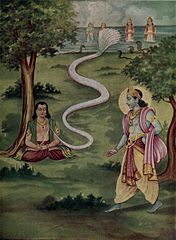Krishna and Radha
Krishna (Sanskrit kṛṣṇa, literally "the black") is according to the Mahabharata and the Bhagavata-Purana a son of Vasudeva and Devaki. However, Krishna cannot be proven historically.
In representations Krishna is traditionally depicted with blue skin and yellow (peetambara) clothing. He always has the Bansuri ('Arrow of the Gods') bamboo flute with him and carries a peacock feather in his hair. He has a crown called 'Kiritina'. Krishna's nicknames include Gopala (Göpãla; Sanskrit for "keeper of the cows / cattle") and Govinda (who brings joy to the cows and the senses). He is also often shown together with a white cow. His Loka is that according to the Narada Pancaratra, the Garga Samhita and the Brahma-Samhita the Goloka ('place of the cows').
Krishna is mostly venerated as the eighth avatar of Vishnu, which gives Puranic narratives about Krishna as in the Bhagavata-Purana, in the Vishnu-Purana and in the Harivamsha-Purana an allegorical meaning.
Krishna applies to his devotees from the Purushottama and Paramatmapurusha to (exaggeratedly) the incarnation of Param Brahman. The tone of his flute is the call that seeks to transform the base and ignorant game of mortal life and instead establishes in him the purple of his divine ānanda.
In this context, Sri Aurobindo (or better the mother Mira Alfassa there) should be mentioned. She said of Krishna: "Krishna, the divine flute player, is the indwelling and unique divine and the supreme attraction. Radha, the psyche, the spiritual personality, answers the call of the highest flute player." (The Mother, Bulletin, Feb. 1961). According to Sri Aurobindo, the child (here Krishna) is a symbol for the psychological transformation in the heart.

Krishna's Bija in Gita are the letters rk. Other common mantras are
- Om (krim) Krishnaya Namah(Moola Mantra) bzw. Om Shri Krishnaya Namaha[7]
- Om Sri Krishnah sharanam namah[8]
- Om (Kleem) Krishnaya namah (e-e entspricht Mahāmāyā)
- Om (Kleem) Krishnaaya Govindaaya Gopeejanavallabhaya swaaha
- Kliim Krishnaaya Govindaaya Gopiijana Vallabhaaya Svaha
- Krishna gayatri mantra: OM DEVAKINANDANAAYA VIDMAHE - VAASUDEVAAYA DHIIMAHI - TANNO KRISHNAH PRACHODAYAAT[9]
In the Sri Krishna Astottara Namavali 108 Names of Krishna are called.
- Krsna, Lord or Avatara? The relationship between Krsna and Visnu: in the context of the Avatara myth as presented by the Harivamsa, the Visnupurana and the Bhagavatapurana, Freda Matchett, 2000, Routledge, ISBN 0-7007-1281-X
- Schweig, G.M., Dance of divine love: The Rasa Lila of Krishna from the Bhagavata Purana, India's classic sacred love story, 2005, Princeton University Press, Princeton, NJ; Oxford. S. 10. ISBN 0-691-11446-3.
- Krishna: A Sourcebook, Edwin Francis Bryant, Oxford University Press,2007, ISBN 978-0195148923, ( Kap. 4-21 )
- Spiritwiki über Krishna
- DLSHQ about Lord Krishna
- Who is Krishna
- The glory of Krishnas birth
- Sri krishna tells the gita
- Vishvarupa - universal form of Krishna
- Mahabharata : 1000 Names pf Krishna
- Youtube : 108 Names of Shri Krishna - Sri Krsna Astottara Shatanamavali
- Gopala govinda rama..
- Eternal form of Vrindavan
- A try : Why did krishna never visit to vrindavan again
- Inner Meanings of Krishna’s Pastimes
- Similarity with Flight into egypt from Herodes who becomes paranoid that the child will threaten his throne, and seeks to kill him
of Spirituality
universal-path.org